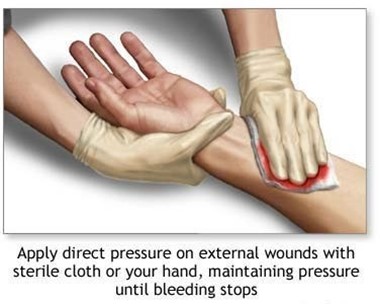A nurse in an emergency department is caring for a client who is bleeding profusely from a deep laceration on his left lower forearm. After observing standard precautions, which of the following actions should the nurse perform first?
Clean the wound.
Apply a tourniquet just below the elbow.
Apply direct pressure over the wound.
Elevate the limb and apply ice.
The Correct Answer is C
Choice A Reason: This is incorrect because cleaning the wound is not a priority when the client is bleeding profusely. Cleaning the wound can also dislodge any clots that have formed and increase bleeding.
Choice B Reason: This is incorrect because applying a tourniquet is a last resort when direct pressure fails to stop bleeding. A tourniquet can cause tissue damage, nerve injury, and infection if applied incorrectly or for too long.
Choice C Reason: This is correct because applying direct pressure over the wound is the first and most effective action to stop bleeding from a wound. This is the first and most effective action to stop bleeding from a wound. Direct pressure compresses the blood vessels and prevents further blood loss. The nurse should use a clean cloth or dressing to cover the wound and apply firm pressure with both hands.
Choice D Reason: This is incorrect because elevating the limb and applying ice are not effective actions to stop bleeding from a wound. Elevating the limb can reduce blood flow to the injured area, but it does not compress the blood vessels or prevent blood loss. Applying ice can cause vasoconstriction, but it can also damage the skin and tissues if applied for too long.

Nursing Test Bank
Naxlex Comprehensive Predictor Exams
Related Questions
Correct Answer is B
Explanation
Choice A: Provide a brightly lit environment is not an intervention that the nurse should take. A brightly lit environment can stimulate the brain and increase intracranial pressure. The nurse should provide a quiet and dimly lit environment to reduce sensory stimuli and promote rest.
Choice B: Elevate the head of the bed is an intervention that the nurse should take. Elevating the head of the bed to 30 degrees can help reduce intracranial pressure by facilitating venous drainage from the brain and decreasing cerebral blood volume. The nurse should avoid flexing or extending the neck, which can impede blood flow and increase intracranial pressure.
Choice C: Encourage a minimum intake of 2000 mL (67.6 oz) of clear fluids per day is not an intervention that the nurse should take. A high fluid intake can increase intracranial pressure by increasing blood volume and cerebral edema. The nurse should monitor fluid balance and restrict fluid intake as prescribed to maintain normal osmolality and prevent fluid overload.
Choice D: Teach controlled coughing and deep breathing is not an intervention that the nurse should take. Coughing and deep breathing can increase intrathoracic pressure, which can increase intracranial pressure by reducing venous return from the brain. The nurse should avoid activities that can increase intrathoracic pressure, such as straining, sneezing, or blowing the nose. The nurse should also administer oxygen as prescribed to maintain adequate oxygenation and perfusion of the brain.
Correct Answer is D
Explanation
Choice A Reason: This is incorrect because magnesium is not a medication for symptomatic bradycardia. Magnesium is a mineral that regulates muscle and nerve function, blood pressure, and blood sugar levels. Magnesium can be used to treat conditions such as torsades de pointes, eclampsia, or hypomagnesemia.
Choice B Reason: This is incorrect because sodium bicarbonate is not a medication for symptomatic bradycardia. Sodium bicarbonate is a substance that neutralizes acids and bases and regulates the pH of the blood. Sodium bicarbonate can be used to treat conditions such as metabolic acidosis, cardiac arrest, or overdose of certain drugs.
Choice C Reason: This is incorrect because epinephrine is not a medication for symptomatic bradycardia. Epinephrine is a hormone that activates the sympathetic nervous system and increases the heart rate, blood pressure, and blood flow to the muscles and brain. Epinephrine can be used to treat conditions such as anaphylaxis, cardiac arrest, or severe asthma.
Choice D Reason: This is correct because atropine is a medication for symptomatic bradycardia. Atropine blocks the action of the parasympathetic nervous system and increases the heart rate and conduction. Atropine is a medication that blocks the action of the parasympathetic nervous system and increases the heart rate and conduction.
Symptomatic bradycardia is a condition where the heart rate is slower than normal and causes symptoms such as dizziness, fatigue, chest pain, or fainting. Atropine can be used to treat symptomatic bradycardia by stimulating the sinoatrial node and the atrioventricular node, which are the natural pacemakers of the heart.

Whether you are a student looking to ace your exams or a practicing nurse seeking to enhance your expertise , our nursing education contents will empower you with the confidence and competence to make a difference in the lives of patients and become a respected leader in the healthcare field.
Visit Naxlex, invest in your future and unlock endless possibilities with our unparalleled nursing education contents today
Report Wrong Answer on the Current Question
Do you disagree with the answer? If yes, what is your expected answer? Explain.
Kindly be descriptive with the issue you are facing.
